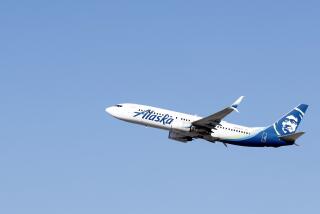Column: Boeing charged extra for safety features. The 737 Max crashes show why that’s a bad idea
The passenger jets that crashed in Ethiopia and Indonesia, killing hundreds, reportedly lacked special safety features in their cockpits — features that Boeing charged extra for.
Meanwhile, buyers of new cars have to decide how much extra they want to shell out for add-on safety features such as lane-departure warnings, technology that could save the lives of drivers and those around them.
This raises an intriguing question for the digital age: Should safety be a premium service?
Put another way, if a plane, car or other machine can be made demonstrably safer through something as simple as a software upgrade or a mechanical tweak, is there an obligation for manufacturers to ensure that users are protected by the most up-to-date features?
Put yet another way, should safety be enjoyed only by those who can afford it?
The answers seem obvious.
“Consumers shouldn’t have to pay extra for safety features, because paying extra means that they are not available to everyone and they’ll cost more than they should,” said Jack Gillis, executive director of the Consumer Federation of America.
“By simply incorporating the latest safety features into a product, two things happen,” he told me. “They are available to everyone, thus everyone benefits, and they become cheaper due to economies of scale.”
But there’s the rub. If a product can be manufactured and sold more cheaply yet still have an adequate level of safety, is it truly necessary to require that everything have the latest-and-greatest technological systems?
Computers can be designed, for example, that are far more difficult to hack than off-the-shelf laptops you might find at Best Buy. But they’ll cost hundreds if not thousands of dollars more.
I doubt anyone would argue that the cheaper, run-of-the-mill devices shouldn’t be sold. Rather, they should be offered on a buyer-beware basis.
Many drivers will say they’re willing to take on a heightened risk with themselves at the wheel. On the other hand, most probably agree that when it comes to aircraft, with strangers at the controls, cutting corners is never a good idea.
The New York Times reported Thursday that Boeing and other aircraft manufacturers routinely offer a variety of safety-related features as add-ons for their high-priced jets.
For example, a backup fire extinguisher in the cargo hold. That sounds like a good thing to have in the event of a mid-air blaze. Some countries require that their carriers have such technology. The Federal Aviation Administration doesn’t.
So Boeing charges extra for the system.
The same approach apparently was taken to an early-warning indicator that might have helped prevent the Ethiopian and Indonesian crashes, if it had been installed on the doomed jets, which it was not.
I reached out to Boeing for comment. No one got back to me.
An FAA investigation is underway. A spokeswoman for the Consumer Product Safety Commission said the agency has no official stand on people paying extra for safety technology.
Consumer advocates, meanwhile, are unequivocal in calling for access to the very latest safety measures.
“Safety should never be optional, let alone monetized for extra profit,” said Emily Rusch, executive director of the California Public Interest Research Group.
“Regulators should evaluate all safety options provided by manufacturers and err on the side of requiring their inclusion, because people’s safety should be the top priority,” she said.
Gillis at the Consumer Federation of America pointed out that everyone benefits when products — and especially modes of transport — are the safest they can be.
“For example, pedestrian avoidance technology,” he said. “Pedestrians benefit even though they don’t own a car. Furthermore, safer products across the board reduce the enormous societal costs of accidents and injuries.
“On the other hand,” Gillis added, “limiting safety add-ons not only increases their price but decreases their overall effectiveness due to less people using them.”
Marsha Cohen, a professor at UC Hastings College of the Law in San Francisco, said a key question is whether people can be trusted to use machines responsibly if the level of safety is merely “good enough,” as opposed to being as high as possible.
“We know consumers — humans! — often fail to consider the need to take actions to protect themselves and others, as we all can observe on the roads with people texting and driving,” she said. “Those are risks for others, not me, right?”
She, too, observed that “if everyone has these safety features, the likelihood is that the costs per unit will drop a great deal, making them less expensive for everyone.”
At the risk of stirring the nanny-state pot, I’ll say Cohen is correct when she suggests we have to protect ourselves from ourselves. Laws against texting while driving are just one example.
Seat-belt laws are another, and helmet laws for motorcyclists. It would be nice if we didn’t need laws to safeguard against stupidity, but that’s not the world we live in.
That’s why I called recently for cellphone signal jammers to be installed in steering wheels.
The bottom line is that the greater the risk to people’s lives and well-being, the greater the obligation to ensure that the most current safety features are incorporated.
That seems especially true if such features are little more than software upgrades and cockpit indicators, as is the case with the improvements missing from the crashed jets.
It’s offensive to think that plane manufacturers and carmakers see enhanced safety as a privilege only for those who can afford it, whether we’re talking airlines or car buyers.
“Safety technologies cannot be solely for the wealthy,” said Sally Greenberg, executive director of the National Consumers League. “If there’s a way to save lives and prevent injuries through technology, it should be standard equipment available to all consumers, regardless of income.”
Boeing apparently agrees. It was reported late Thursday that the company will start including as a standard feature on the 737 Max some of the safety gear that had been optional.
But look what it cost to get there.
David Lazarus’ column runs Tuesdays and Fridays. He also can be seen daily on KTLA-TV Channel 5 and followed on Twitter @Davidlaz. Send your tips or feedback to [email protected].
More to Read
Inside the business of entertainment
The Wide Shot brings you news, analysis and insights on everything from streaming wars to production — and what it all means for the future.
You may occasionally receive promotional content from the Los Angeles Times.











